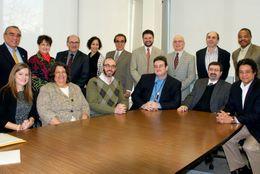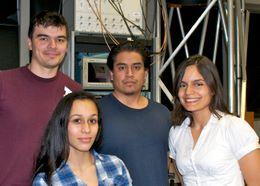

Above: Faculty and administrators from The City College of New York, Hostos Community College and LaGuardia Community College meet for the inauguration of the Alliance for Continuous Innovative Learning Environments in STEM (CILES). Below: Earth System Science and Environmental Engineering students Carlo Carrizo (left), Arleny Valle, Omar Ramales and Yanelly Molina.
Aim to Increase Number of Hispanic, Low-Income Students Earning Degrees
The City College of New York and two CUNY community colleges are partnering on a multifaceted initiative to attract more students to the STEM disciplines – especially Hispanics and low-income students – and help them earn their degrees. Producing more STEM (Science, Technology, Engineering and Mathematics) graduates is critical to strengthening U.S. competitiveness in the global economy.
The program, called the Alliance for Continuous Innovative Learning Environments in STEM (CILES) is funded through a five-year, $4 million grant from the U.S. Department of Education and will be housed within the CUNY CREST Center. Hostos Community College in the Bronx and LaGuardia Community College in Queens, are participants in the project, in addition to CCNY. Key program objectives include:
- Improving and expanding articulation programs that help students transfer from Hostos or LaGuardia to City College.
- Supporting students’ learning needs from high school to community college to senior college through continuous learning communities and mentorship by maximizing use of information technology.
- Attracting new students to the STEM fields via outreach and integrating K-12 students into the learning communities.
- Professional development for faculty in use of modern technology and learning communities.
- Scaling the project to other programs within and outside CCNY through assessment of the learning experiences, dissemination and knowledge transfer.
Hispanics, who comprise the largest ethnic group at the three institutions, have traditionally been underrepresented in STEM. In 2008, they received less than 14 percent of engineering degrees awarded by U.S. colleges and universities, but they represent 16.3 percent of the U.S. population, according to the latest census. With their population forecast to double to 100 million by 2050, increasing the Hispanic presence in engineering and other STEM fields takes on heightened importance.
“We will be adopting programs tried elsewhere that have been shown to produce significant improvement in student retention rates,” said Dr. Jorge Gonzalez, NOAA-CREST Professor of Mechanical Engineering at CCNY. “Our focus will be the earth system science and environmental engineering majors, but we would like to expand this across all STEM programs.”
CILES has set a target of increasing the number of majors in earth system science and environmental engineering from 81 to 160 by fall 2016. Because approximately half of the undergraduates in the Grove School of Engineering transfer in from community colleges, smoothing their transition to CCNY is one of the primary objectives.
“Our hypothesis is if we can provide a continuous learning environment from where they begin to here, they will have an easier time adjusting,” Professor Gonzalez explained. This environment will incorporate online tools such as social networking and virtual learning communities as well as in-person mentoring and tutoring provided by graduate students in breakout rooms that can accommodate small groups.
Six of the rooms will be constructed – two on each campus. They will be similar to facilities in City College’s new City Tech center, located in the North Academic Center, which provides computers for all CCNY students to use. Professor Gonzalez anticipates that introduction of continuous learning environments will produce a 50 percent improvement in student retention rates within five years, from 40 percent to 60 percent.
In addition to the continuous learning environment, the plan calls for curriculum changes to put greater emphasis on critical thinking skills, hands-on education and multidisciplinary coursework. “We think students may lose motivation as they go through the program because they are not connected to the technology,” he said. “We want them to be more connected to the lab as we teach and engage in more critical thinking so they can think problems through and find multiple solutions.”
Students at all three schools will be trained in the same skill sets. Labs and lectures will be modernized to facilitate hands-on individual and team projects and interdisciplinary learning. At CCNY, 5,000 square feet of space will be allocated to create a single, continuous learning facility that will integrate classrooms, a laboratory and breakout rooms. The laboratory design calls for open spaces with discipline-specific portable modules accessible to all students.
To further develop their critical thinking skills, students from all three campuses will be encouraged to apply for undergraduate research experiences, particularly those offered through the NOAA-CREST center at CCNY. Students accepted into such programs may be able to begin working toward their senior thesis project during the sophomore year.
Other elements of the grant include faculty workshops, more seamless transition for students transferring from the community colleges to CCNY and continuous assessment of student programs through data collected from the use of information technology in the continuous learning environments.
Faculty and graduate students from all three campuses will be trained in the use of virtual learning environments as well as hand-on and multidisciplinary instruction. Expanded articulation programs would enable students with associates’ degrees in engineering science and a “C” or higher cumulative average to transfer seamlessly to upper division programs in earth system science and environmental engineering, computer sciences and engineering and biomedical engineering at CCNY.
In addition to Professor Gonzalez, project leadership includes Professor Yaseer Hassebo of LaGuardia Community College and Professor Nieves Angulo of Hostos Community College and Professor Jeff Steiner of City College as co-principal investigators, and CCNY Professors Fred Moshary, Barry Gross and Karin Block.
On the Internet
- Earth System Science and Environmental Engineering at City College
- CUNY CREST Center
- Hostos Community College
- LaGuardia Community College
MEDIA CONTACT
Ellis Simon
p: 212.650.6460
e:
esimon@ccny.cuny.edu